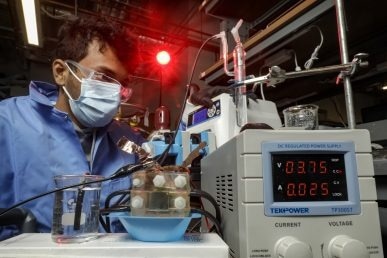
UIC Engineering student Rohan Sartape with a Migration Assisted Moisture Gradient CO2 capture unit. Image Credit: Jim Young/UIC Engineering
The UIC team’s method is the first to accomplish a nearly 100% utilization of carbon dioxide to make hydrocarbons, although researchers have been looking into the prospect of turning carbon dioxide into ethylene for over a decade.
With the use of electrolysis, their method converts collected carbon dioxide gas into high purity ethylene, with byproducts of other carbon-based fuels and oxygen.
Almost all of the captured CO2 can be recycled by this process, converting up to six tons of carbon dioxide into one ton of ethylene. The process can be carbon negative by using renewable energy since the system is powered by electricity.
Singh claims that by lowering the overall amount of carbon dioxide produced by industry, his team’s method outperforms the net-zero carbon objective of existing carbon capture and conversion methods.
It is a net negative. For every 1 ton of ethylene produced, you are taking 6 tons of CO2 from point sources that otherwise would be released to the atmosphere.
Meenesh Singh, Assistant Professor, Chemical Engineering, University of Illinois Chicago
In the past, attempts to transform carbon dioxide into ethylene relied on reactors that produce ethylene from the source stream of carbon dioxide emissions.
In these circumstances, just 10% of CO2 emissions typically undergo ethylene conversion. Later, in an energy-consuming process that frequently uses fossil fuels, the ethylene must be separated from the carbon dioxide.
The UIC method involves passing an electric current through a cell divided into two halves, one half filled with collected carbon dioxide and the other with a water-based solution.
An electrified catalyst pulls charged hydrogen atoms from the water molecules into the other side of the unit, divided by a membrane. They are mixed with charged carbon atoms from the carbon dioxide molecules to create ethylene.
Ethylene is the third-highest emitter of carbon dioxide in the world among manufactured chemicals, behind cement and ammonia. Ethylene is used to make chemicals for antifreeze, medical sterilizers, vinyl siding for houses, and plastic products for the packaging, agricultural, and automotive industries.
A procedure called steam cracking, which necessitates considerable heat, is typically used to produce ethylene. For every ton of ethylene produced, cracking results in around 1.5 metric tons of carbon emissions.
More than 260 million tons of carbon dioxide are emitted each year globally due to manufacturers' annual production of about 160 million tons of ethylene.
The UIC researchers’ electrolysis method allowed them to manufacture other carbon-rich compounds beneficial to the industry in addition to ethylene. A significant solar energy conversion efficiency was also attained, with 10% of the energy from the solar panels being converted directly into carbon product manufacturing.
This is significantly higher than the modern standard of 2%. The efficiency of solar energy conversion for all the ethylene they produced was about 4%, almost the same as photosynthesis.